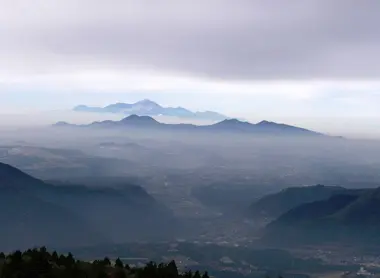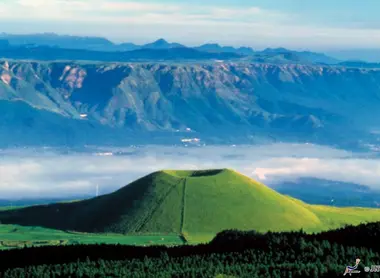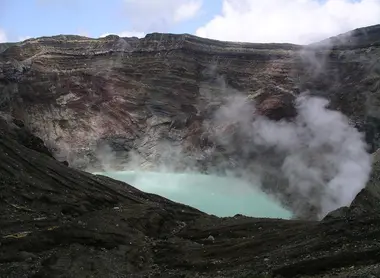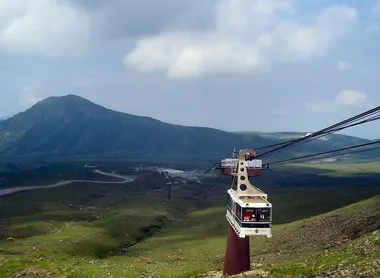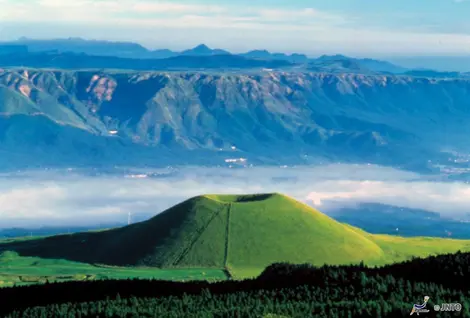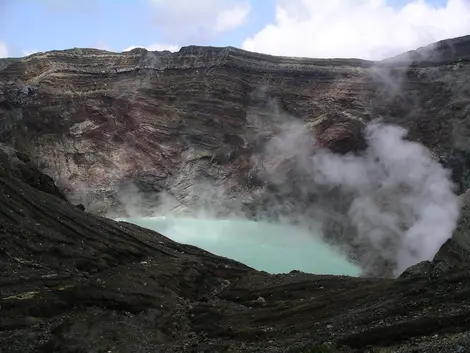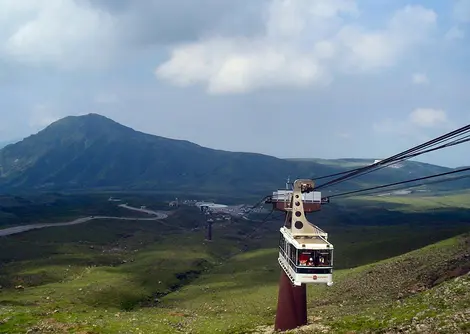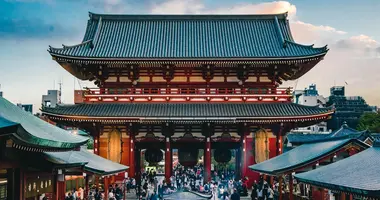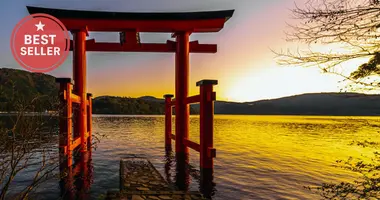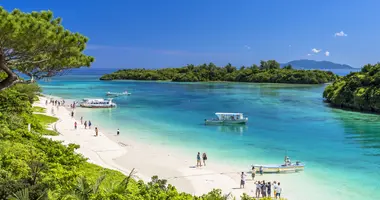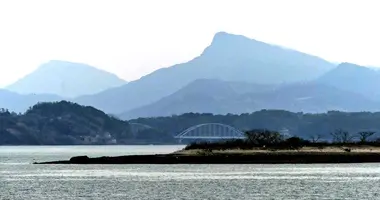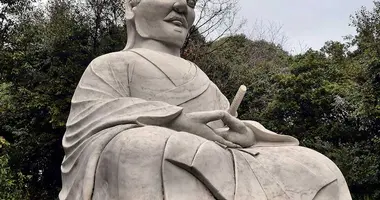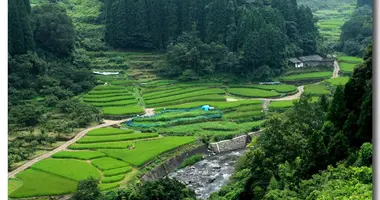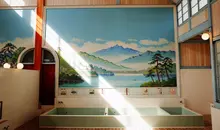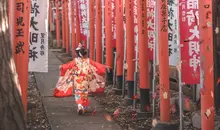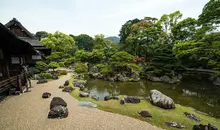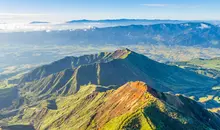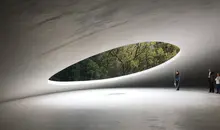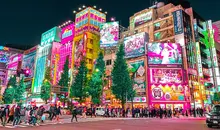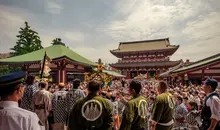Mount Aso Kumamoto: the active volcano and its natural wonders
- Published on : 07/10/2015
- by : G.L.
- Youtube
Land of Fire
In the heart of the island of Kyūshū, Mount Aso (阿蘇山, Aso-san) dominates the Japanese landscape with its impressive caldera, one of the largest in the world. This volcanic colossus, still in activity, offers visitors a fascinating natural spectacle combining snow-capped peaks, hot springs, wild landscapes and age-old traditions. Located near the city of Kumamoto, this volcanic complex is one of the island's main tourist attractions. With a circumference of almost 128 km, it is home not only to Japan's most active volcano, but also to some 15 volcanic cones and around 100,000 inhabitants living within its caldera.
Introduction to Mount Aso and its geographical location
Mount Aso is located in the center of the island of Kyūshū, in Kumamoto prefecture, about 1.5 hours' drive from the town of the same name. Reaching an altitude of 1,592 metres, it is only 75 kilometers east of Mount Unzen and 150 kilometers north of the Sakurajima volcano. This mountainous region is Japan's most active volcanic zone, precisely at the intersection of the volcanic chains that cross the island from north to south and east to west.
There are several options for getting there. The most practical is to rent a car, as public transport services are limited in this rural region. You can also take a local train or express bus from Kumamoto station to Aso station (approx. 2-hour journey), then a local bus to the mountain. For the more adventurous, a unique experience is to fly over the crater by helicopter from the Cuddly Dominion Zoological Park, offering a breathtaking view of the entire massif.
The small town of Aso, nestled in the hollow of the depression, is the ideal starting point for visitors wishing to explore the region. The surrounding area abounds in charming spas, such as the famous Kurokawa Onsen, renowned for its traditional ryokans and open-air baths.
The Aso caldera: formation, dimensions and volcanic cones
The Mount Aso caldera was formed between 300,000 and 80,000 years ago during four major eruptive phases (named Aso 1 to 4). These cataclysmically powerful eruptions carved out immense cavities in the underground magma masses, leading to the collapse of the basement and the formation of this gigantic volcanic depression. The fourth and largest phase produced pyroclastic flows that spread over half the island of Kyūshū, and ash was found as far away as Yamaguchi prefecture on the island of Honshū.
Between 80,000 and 70,000 years ago, the caldera took on its present form and the main volcanic cones were formed (with the exception of Neko-dake, considered to be earlier). With its impressive dimensions - 25 km from north to south, 18 km from east to west and a circumference of around 120 km - it is one of the largest calderas in the world.
Within this vast depression are five main cones that make up what is commonly known as Mount Aso:
- Naka-dake: 1,506 meters, the most active and most visited, with a crater 600 meters in diameter and 160 meters deep containing a green acid lake
- Taka-dake: the highest at 1,592 metres
- Neko-dake: 1,408 metres, considered the oldest
- Kijima-dake: 1,321 metres
- Eboshi-dake: 1,337 metres
In addition to these main peaks, there's also Komezuka, a small extinct volcano covered with green grass in spring, whose symmetrical shape evokes that of a clod of rice, becoming one of the site's iconic images. From the Kusasenri plateau, you can admire this perfect cone while contemplating the exceptional panorama of the entire volcanic massif.
Volcanic activity and safety precautions
Mount Aso is one of Japan's most active volcanoes. Since the year 533, the date of the first documented eruption in the archipelago, over 160 eruptions have been recorded. From historic times onwards, volcanic activity has been concentrated mainly on Naka-dake, which today remains the most closely watched cone.
Recent history bears witness to this intense activity: eruptions in 1965, 1975 and 1980, followed by several eruptive phases in 2014, including major explosions in November that necessitated raising the alert level and disrupted air traffic. In October 2016, vulcanologists witnessed a so-called "explosive" eruption on one of the peaks, which had not awakened since 1980. The last major eruption was on October 20, 2021, when volcanic ash rose to 3,500 meters, without causing any casualties.
In view of these potential dangers, strict safety measures have been put in place. In the 1990s, concrete bunkers were built around the Naka-dake crater to protect hikers from splashes in the event of an eruption. Despite these precautions, tragic accidents have occurred, as in 1997, when 7 people died and 70 were injured by sulphur gas poisoning.
Today, in the event of serious volcanic activity or significant emissions of toxic gases, access to the crater is strictly forbidden up to 2 kilometers away. The cable car that once provided easy access to Naka-dake has been permanently closed since the earthquakes of April 2016. Visitors are therefore advised to check with the Kumamoto or Aso tourist offices before setting off, and to scrupulously observe the safety instructions.
Hiking and panoramas: discover the emblematic landscapes of Mount Aso
The Mount Aso massif offers a wide range of hiking possibilities for all levels, allowing you to appreciate its unique landscapes from different angles. Aso-Kuju National Park, one of Japan's first national parks, is a must for hiking and other outdoor sports enthusiasts.
The ascent of Mount Taka-dake, the highest at 1,592 metres, is a moderately demanding hike with a vertical drop of around 750 metres. At the summit, hikers are rewarded with a sublime view of the entire volcanic massif and caldera. However, this hike is often closed due to the risk of eruption. For a more accessible alternative, Mount Eboshi-dake offers an easier route with around 200 meters of ascent and spectacular views, rarely closed as it is further from the active crater.
For the less athletic, several remarkable viewpoints are easily accessible:
- Daikanbō, the region's most famous viewpoint, offering a perspective named "Nehanzō" that evokes the silhouette of a reclining Buddha
- Mount Ogidake, offering 360-degree views not only of Mount Aso but also of the Kuju Mountains and Mount Sobo
- Kabuto Iwa, located on the north-western edge of the caldera's outer rim
- The Sankinkōtai road, a historic route once used by the lords of Higo to reach the capital
- Futae Pass, sometimes offering the magical spectacle of a sea of clouds
One of Mount Aso's most emblematic landscapes is the vast Kusasenri plain, a crater transformed into a meadow where horses and cows graze. Horseback riding is available between March and December. This grassy expanse, nestled between Mount Kishima and Mount Eboshi, has long been celebrated by Japanese poets and artists. The large pond here reflects the sky, creating an atmosphere of serenity perfect for contemplating the Five Peaks of Aso without having to climb them.
The hot springs (onsen) around Mount Aso
Mount Aso's volcanic activity has fostered the development of numerous hot springs (onsen) with a variety of curative properties. These spas are one of the region's main tourist attractions, offering an ideal moment of relaxation after a day exploring the volcano.
Among the most famous onsen is Kurokawa Onsen, a traditional spa north of Mount Aso. This charming spa village comprises some 30 traditional inns (ryokan) lined up along a 4 km stretch of the Tanoharu River, in the heart of a forested valley. What makes it so special is its conception as a "single ryokan", where each establishment is considered a room, each alley a corridor and each landscape a facet of the garden. This unifying vision creates a competitive-cooperative relationship between the establishments.
Kurokawa Onsen is famous for its practice of "rotenburo meguri" (or "onsen hopping" in English), which involves touring the outdoor baths. Visitors can purchase a wooden pass called a "nyuto tegata", giving access to three of a list of twenty-four participating establishments. At each bath visited, the receptionist stamps this wooden disc, which some visitors then donate to the Jizo temple.
Closer to Mount Aso, the Uchinomaki onsen boasts several thermal baths fed directly by the same natural underground spring. Affordable rates (from 100 to 1,000 yen) mean you can visit several types of hot springs in a single day. The common feature of Uchinomaki's waters is the presence of metasilicic acid, which in small quantities increases the pleasure of bathing tenfold. The breathtaking view of the surrounding mountains adds to the charm of the experience.
Other notable hot springs in the region include :
- Akamisu Onsen
- Jigoku Onsen (literally "hot spring from hell")
- Tarutama Onsen
- Yunotani-Aso Onsen
- Tsuetate Onsen
These mineral-rich thermal baths offer numerous health benefits, while immersing you in authentic Japanese tradition.
The Aso-jinja sanctuary and the region's cultural heritage
Beyond its natural wonders, the Mount Aso region boasts a rich cultural heritage, the jewel in the crown of which is undoubtedly the Aso-jinja Shrine. Considered one of the oldest and most important shrines in Japan, it is said to have been founded in 281 BC, making it an exceptional witness to Japanese religious history.
The Aso-jinja shrine is dedicated to the veneration of Tateiwatatsu-no-Mikoto, grandson of Japan's first mythical emperor and brother of Emperor Suizei. Sent to Aso, he is said to have helped found numerous farming communities in the region. Today, the guardian god Aso-no-Ōkami who resides at the shrine is revered as a protector against traffic accidents and other misfortunes.
Unfortunately, this historic site was severely damaged in the earthquake that struck Kumamoto in 2016. The splendid Rōmon portal, classified as a national treasure and dating from the late Edo period (1603-1868), collapsed, as did the main worship hall. Despite the damage, the shrine remains open to visitors and reconstruction work continues, with the aim of restoring these historic elements to their original state, using as much of the original materials as possible.
Close to the shrine is the Ichinomiyamachi Miyaji shopping street, where each shop has its own source of drinking water. Here you'll find local handicraft stores, a stationery store selling colorful Japanese fabrics, and the Tanoya pastry shop, renowned for its delicious cream puffs.
To the south-east of the massif, the village of Takachiho is another of the region's cultural hotspots. It is here that tradition places certain episodes in the life of Amaterasu, goddess of the sun and mythical ancestor of all Japanese emperors (also venerated at the Ise sanctuary). At night, by the light of torches, Shinto ritual dances known as "kagura" perpetuate ancestral traditions rooted in the very origins of Japanese culture.
For lovers of religious heritage, the Kamishikimi Kumanoimasu shrine, located to the south-east of the volcano's slopes, is also well worth a visit. Nestled in the heart of a forest, it is reached by a 270-step staircase lined with stone lanterns and punctuated by torii (traditional portals). Halfway up is the famous green torii, particularly photogenic. The site is also home to the sacred Ugeto Iwa rock, a 10-metre natural arch considered a holy site.
Practical tips for visiting Mount Aso: transport, accommodation and best times to visit
To make the most of your visit to Mount Aso, here are a few practical tips to help you organize your stay:
Transportation
Car rental remains the most practical option for exploring the region freely, as public transport is limited. If you prefer public transport, you can :
- Take a local train or express bus from Kumamoto station to Aso station (approx. 2h journey)
- From Aso station, take a local bus to Mount Aso (approx. 30-40 minutes)
To reach the Naka-dake crater, you can take the Aso Park road (fee payable), take a shuttle bus or walk the distance (approx. 30 minutes). As the cable car has been permanently closed since the 2016 earthquakes, these alternatives are now the only possibilities.
Accommodation
There are several options for your stay:
- Sleep in Kumamoto or Takachiho and take a day trip to Mount Aso
- Stay in a traditional ryokan at Kurokawa Onsen and enjoy the thermal baths
- Choose accommodation near Mount Aso to watch the sunrise or sunset over the volcano
Recommended establishments near Aso include:
- The Sozankyo ryokan at Uchinomaki Onsen, run from father to son for 200 years
- Syukubo Aso, 3.9 km from Mount Aso and 600 m from Aso station
- Fairfield by Marriott Kumamoto Aso, appreciated for its cleanliness and location
- Minshuku Asogen, a traditional inn with private onsen
Best times to visit
Mount Aso can be visited all year round, but certain periods offer special experiences:
- Spring (March-May): ideal for admiring the verdant meadows and green grass-covered Komezuka
- Autumn (September-November): silver pampas grass (susuki) covers the plains, adorning the landscape in golden hues
- Winter (December-February): less frequented, with the chance to admire the frozen Koga Falls, but beware of roads that are sometimes closed due to snow
If possible, avoid Golden Week (early May) and autumn, the busiest periods for Japanese tourists.
Additional practical information
- Always check forvolcanic activity before your visit on the Aso tourist office website (available in English at http://www.city.aso.kumamoto.jp.e.pw.hp.transer.com/)
- Bring warm clothing even in summer, as temperatures can be cool at higher altitudes
- Visit the Aso Volcano Museum (880 yen) to learn about the geology and history of the site
- For a complete experience of the region, consider the Kyushu cult tour, which includes Mount Aso and other remarkable sites on the island
By following these tips, you'll be able to take full advantage of the wild and majestic beauty of Mount Aso, this "land of fire" which, despite its unpredictability, continues to fascinate travellers from all over the world with its grandiose landscapes and exceptional cultural heritage.
